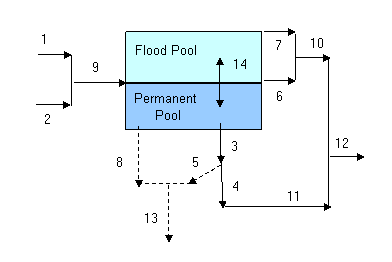

Mass Balance Terms:
01 Watershed Inflows - net inflow from watersheds assigned to device; for aquifers: percolation - evapotranspiration
02 Upstream Device - inflow from upstream devices
03 Infiltrate - outflow passing through bottom/sides of device through outlet # 1
04 Exfiltrate - equals Infiltrate(03) minus Filtered(05)
05 Filtered - mass removed during infiltration
(trapped in soil)
06 Normal Outlet - outflow passing thru outlet number 2
07 Spillway - outflow passing thru outlet number 3 used as a "relief" outlet when device is full
08 Sedim.+Decay - mass removed via sedimentation &/or decay
09 Total Inflow - sum of inflows from watershed & upstream devices
10 Surface Outflow - sum of outflows thru outlets 2 & 3; also includes outlet 1, if its device number > 0 & it is not an aquifer
11 Groundw Outflow - outflow thru outlet 1, if its device number = 0 or it is an aquifer12 Total Outflow - sum of surface & groundwater outflows
13 Total Trapped - sum of sedimentation , decay, & filtration
14 Storage Increase - increase in storage volume ( or mass ) from one time step (or event) to the next.
15 Mass Balance Check - error term in mass-balance
equation should be small in relation to total inflows if appropriate time steps
are used.
Mass Balance Equations:
Inflows = Outflows + Increase-in-Storage + Removals + Error
Inflows = Watershed Runoff + Percolation$ + Inflows from Upstream Devices
Percolation = Rainfall + Snowmelt - Runoff
Outflows = Infiltration + Normal Outlet + Spillway + Evapotranspiration$
Increase-in-Storage = Final Storage - Initial Storage
Removals = Sedimentation + Decay
Error = Continuity Error (by Difference)
$ Terms relevant to
Aquifer
devices only.
Mass balance errors are expressed on on a percentage basis (Term 15 / Term 9) x 100% and reported in program output.
Large errors in water or mass balances generally indicate that the simulation time steps per hour should be increased ( General input screen). Many problems will run with a time step of one hour. Shorter steps (more steps per hour) may be necessary in devices that dry out frequently or otherwise have highly dynmaic flows and/or depths.
See also Figure 3 of P8 Version 1 Program Documentation